Crossovers are criticized – correctly – for looking and being the same, as if cut from the same mold, regardless of badge.
Most of them have similarly bland drivetrains – and not much choice about the drivetrain. It comes as it is – and that’s all there is.
The Hyundai Sante Fe does a good job of not being like most of the rest. It’s another crossover, yup – but it doesn’t look so much like the rest that it’s hard to tell it apart. But it’s what’s under the hood – or rather, what you can choose to be under the hood – that sets the Sante Fe apart.
What It Is
The Sante Fe is Hyundai’s next-up-in-size crossover after the compact-sized Tucson. It is a two-row, mid-sized alternative to the three-row, full-sized Palisade and can be compared with other two-row, mid-sized crossovers such as the Ford Edge.
It is also related to its cousin, the Kia Sorento – which is slightly longer and offers a third row at the expense of some cargo-carrying capacity behind that row.
The Sante Fe (like its Kia-badged cousin) is available with either of two engines and your choice of AWD or not, with either engine – a rare choice among crossovers in this class, most of which offer either a single take-it-or-leave it drivetrain or give you the choice of a standard, not very powerful engine – or the choice to buy a more powerful one that automatically comes with AWD.
Prices start at $27,200 for the base SE trim with a 2.5 liter engine, eight speed automatic and front-wheel-drive. You can opt for AWD, which increases the MSRP to $28,900.
If you want more power, a turbocharged version of the 2.5 liter engine is available in the Limited and Caligraphy trims, which sticker for $38,960 and $40,960 to start, respectively. Interestingly, you have the option to skip – or buy – all-wheel-drive with this engine. Generally, all-wheel-drive is bundled with the optional/stronger engines in rival crossovers – forcing you to buy it even if all you wanted to buy was more power.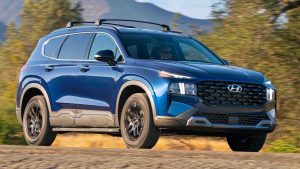
Also of interest, you can get the turbo version of the 2.5 liter engine in the essentially similar Kia for substantially less – in the $34,990 to start EX trim of that model.
What’s New
A new XRT trim is available that emulates the Outback theme Subaru applies to some of its models. You get a roof rack, lower perimeter body cladding (with built-in side steps) that won’t get chipped by rocks, skid plates an 18-inch wheel/-tire package and various trim upgrades.
The current Sorento doesn’t offer anything directly similar.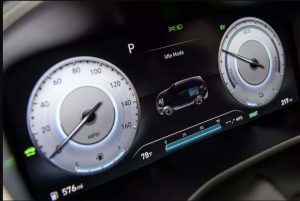
There is also a new plug-in version of the Sante Fe hybrid that can travel about 30 miles on electricity-only but which doesn’t have to be plugged in to keep on traveling – as is the case with plug-in-only electric cars.
It stickers for $40,535 to start, topping out at $46,545.
What’s Good
You can get the optional, more powerful engine without paying extra for AWD – unless you want to.
Conventional, eight speed automatic rather than CVT automatic.
Priced lower to start than its Kia-badged cousin (which starts at $29,390).
You can get the more powerful, optional engine – the same engine – in the Sante Fe’s Kia-badged cousin at a much lower price point ($34,990 for the EX Turbo vs. $38,960 for the Sante Fe Limited).
Plug-in hybrid’s $40k-plus price to start will take a while to work off in at-the-pump savings.
All trims come standard with driver “assistance” electronics, including Lane Keep Assist, Automated Braking Assist and a “drowsy driver” monitor.
The Sante Fe is a crossover – which is as unusual as sunlight in the morning. But there are a few unusual things about it. It offers the usual standard and optional engine – the former being a 2.5 liter four cylinder, without a turbocharger, that makes 191 horsepower and 181 ft.-lbs. of torque; the latter being a turbocharged version of this engine that makes 281 horsepower and 311 ft.-lbs. of torque.
So far, nothing unusual. Almost every other crossover comes with a four cylinder engine, with or without a turbocharger.
It’s what the Sante Fe’s engines are paired up with – and what you can pair them with – that makes them unusual.
Which isn’t a continuously variable (CVT) automatic transmission.
Most crossovers come with CVTs – which don’t shift through gears but transition through ranges – because of the slight (2-3 MPG overall is typical) fuel-efficiency advantage, which helps the company selling the vehicle comply with ever-upticking federal fuel efficiency mandates. It is helps sell the vehicle to people who want the maximum-mileage possible. But many people dislike the operating characteristics of CVTs, which have a different feel and sound. Some people like the more traditional feel and sound of a transmission that shifts from gear to gear – and that’s what you get here.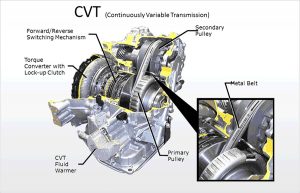
The base 2.5 liter engine without the turbocharger is paired with a conventional eight speed automatic. And it still manages 25 MPG in city driving and 28 on the highway; with AWD this dips slightly to 22 city, 25 highway. These numbers are bit lower than some of the others in the class but not hugely.
And no CVT.
If you opt for the turbocharged 2.5 liter engine by choosing the Limited or Caligraphy trim, you get an eight speed dual-clutch automatic, which is a quicker-shifting type of automatic. With the more powerful engine, mileage stats are 22 city, 28 highway with FWD and 21/28 with AWD.
Which brings us to the other unusual thing about the Sante Fe relative to most crossovers.
Most – almost all of them – bundle all-wheel-drive with their optional, more powerful engines. Whether this is done out of concern for “safety” – all that extra power going to just the front wheels means you’d be able to spin them – or for mercenary reasons (you want more power? You’ll have to pay extra for the engine and the AWD) is immaterial as regards this Hyundai.
If you want the stronger engine – and don’t want AWD – you can buy a Sante Fe that way. Or you can buy it with AWD. You’re not pigeonholed into buying the stronger engine and AWD.
You can also get AWD with the standard engine.
No up-selling you to get the extra traction – or less, if that’s what you prefer.
Both engines are also regular fuel engines – including the turbo’d engine. That saves you about 30 cents per gallon at every fill-up, which works out to about $6 or so for every 18.8 gallon fill-up. Not small change over time.
You can pull up to 3,500 lbs. with this buggy – a solid tow rating for the size and class.
Hyundai is to Kia what Buick was to Pontiac back in the day.
For those who don’t remember those days (Pontiac was retired back in 2010 but had been dead for many years prior to that) GM used to offer different permutations of shared-platform vehicles, with some sportier than others and some more luxurious than others. Buicks were softer-riding and tended to be more regal-looking and a bit posher than Pontiacs, which were rowdier in their styling and usually set up to deliver a sportier driving feel.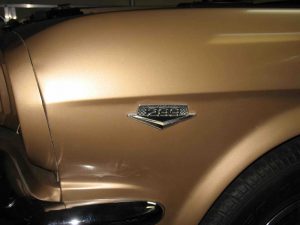
There’s a similar difference between the Sante Fe – the Hyundai – and the Sorento, the Kia. If you drive the two one after the other you will notice this and can then decide for yourself which nuance you prefer. The drivetrains are identical, so there’s little if any difference in how they feel when you push down on the accelerator pedal. The standard engine provides par-for-the-class giddyap and buyers who prefer the little snap that occurs whenever a conventional automatic changes from one gear to the next will like that – as opposed to the CVT automatic’s surge through its ranges, which to some people feels like the transmission is failing (and sometimes sounds like it).
With the optional turbocharged engine, the Sante Fe – and Sorento – are capable of reaching 60 MPH in six seconds – which (for those who remember) is as quick as most V8 muscle cars of the ‘60s were. The little four’s swell of torque is also comparable to that produced by many the V8s of that era (compare the numbers to those of a ’66 Mustang GT’s 289 Hi-Po V8) and gives the Hyundai – and the Kia – a stronger low and mid-range than the base-engined versions of these vehicles, which require more pressure on the accelerator to get them accelerating.
But the main difference you’ll feel is in the seat of your pants rather than the small of your back. The Sante Fe is softer, plusher. The Sorento more supple. One – the Kia – feels a little more confident when tossed into a curve at higher speeds. The other – the Hyundai – feels more relaxed, all the time. These attributes are neither good nor bad. Just different – which is good, as it means you get to choose.
Which is always better than one-size-fits-all.
All trims do come standard with an array of “assistance” technology – including Lane Keep Assist and Automated Brake Assist – but these “assists” can mostly be avoided, by turning them off. The aggravating thing is having to buy what you may not need – or want. This includes ASS – automated stop/start “technology” – which shuts off the engine at practically every red light – unless you stop it, by pushing the button on the console, to turn ASS off.
The previous generation Sante Fe (2018 and prior) was available in Sport and XL versions, with the former being bridging the gap between the compact-sized latter and larger-sized, three-row crossovers.
The current Sante Fe splits the difference.
It is longer than the previous-generation Sante Fe Sport by about three inches but not as long as the previous, nearly full-sized regular Sante Fe – which was 193.1 inches long vs. 188.4 inches for the current iteration (the previous-generation Sante Fe Sport was 185 inches long).
This footprint is solidly mid-sized, almost exactly the same as others in the class such as the Ford Edge – which is 188.8 inches long overall).
Hyundai decided to offer the new Sante Fe in two-row configuration only, as opposed to offering a smaller, two-row version and a larger, three-row version as previously. If you need a third row, there’s the full-sized Palisade – or the Sante Fe’s Kia-badged cousin, the also mid-sized Sorento – which sacrifices behind-its-third-row cargo capacity to carve out the space for it.
Instead of 36.4 cubic feet with the two rows in place, as in the Hyundai – you get the extra row but only 12.6 cubic feet behind it. Both cousins have about the same total cargo capacity when their second (and second and third) rows are down: 72.1 cubic feet for the Sante Fe and 75.5 for the Sorento.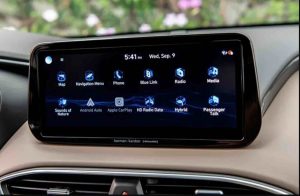
If you need more of both, the Palisade – or its Kia-badged cousin, the Telluride – have got you covered. These larger, three-row crossovers also still come standard with V6 engines, by the way.
Hyundai does a top-shelf job of blending tech with function. LCD displays abound, but there are rotary knobs with feel to adjust volume and change channels. You can feel the click as opposed to the tap and swipe. There are multiple USB hook-ups but they didn’t forget the 12V power point – so you can still plug in accessories that don’t feed off USBs, such as radar detectors.
The objective criteria that once clearly defined a luxury vehicle from one that wasn’t no longer do. This Hyundai is available with such niceties as quilted leather door panel inserts, heated and cooled seats, a configurable LCD dashboard (something that, as recently as five or six years ago, one found only in very expensive luxury cars such as the Mercedes E and S-Class sedans) with a 10.25 inch secondary LCD cluster, a 12 speaker audio system and panorama glass roof.
Amenities such as climate control AC and power windows, locks and seats, cruise control, etc. are what ashtrays once were – i.e., the bare minimum expected, even in economy cars.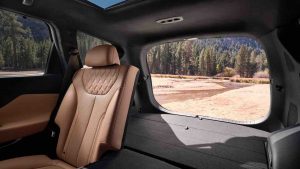
This is great news for people who like luxury but would rather not pay for it. It’s not-so-good news for car companies trying to sell luxury-brand vehicles that – increasingly – don’t offer much more for your money except that they cost more money.
The one thing that will cost you more money here is more power – vs. what it would cost you across the street at the Kia store, where you can pick up an essentially similar Sorento EX with the same 281 hp turbocharged version of the 2.5 liter engine for $3,970 less than that engine costs under the hood of a Sante Fe. This is so because Hyundai only puts the stronger engine in the top two Sante trims – Limited and Caligraphy – while Kia offers it in all but the base LX and S trims, which come with the non-turbocharged version of the 2.5 liter engine.
On the other hand, the Sorento isn’t available with the rugged XRT package that is now available in the Sante Fe – and the Sante Fe’s base price ($27,200) is significantly less than the Sorento’s ($29,390), if you’d rather not pay extra for a third row you may not need – and maybe just prefer the Sante Fe’s looks.
The Bottom Line
It’s not easy, usually, coming up with a reason to buy one crossover vs. another. But Hyundai gives you a couple of them, here.
. . .
Got a question about cars, Libertarian politics – or anything else? Click on the “ask Eric” link and send ’em in! Or email me at [email protected] if the @!** “ask Eric” button doesn’t work!
If you like what you’ve found here please consider supporting EPautos.
We depend on you to keep the wheels turning!
Our donate button is here.
If you prefer not to use PayPal, our mailing address is:
EPautos
721 Hummingbird Lane SE
Copper Hill, VA 24079
PS: Get an EPautos magnet or sticker or coaster in return for a $20 or more one-time donation or a $10 or more monthly recurring donation. (Please be sure to tell us you want a magnet or sticker or coaster – and also, provide an address, so we know where to mail the thing!)
My eBook about car buying (new and used) is also available for your favorite price – free! Click here. If that fails, email me at [email protected] and I will send you a copy directly!

















OK, I understand the Hyundai/Kia to Buick/Pontiac comparison. And the 50 year old Hi-Po Mustang comparison too. That last one is not exactly “apples to apples,” though.
Hey, wouldn’t it be fun to flip the coin over, and compare the price/performance of these very nice new Koreans to a 2021 Mustang GT? I know, that’s not exactly “apples to apples” either. But fun and enlightening, nevertheless. 🙂